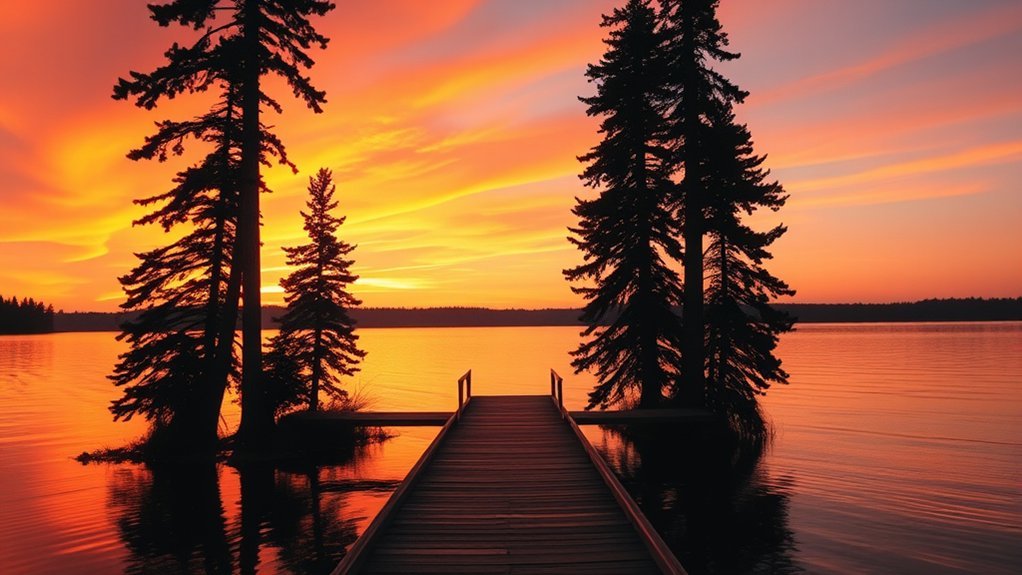Did you know that the quality of light during the Golden Hour can drastically change within minutes? This fleeting window offers unique opportunities for photographers, but it requires careful planning and execution. To capture those stunning images, you’ll need to contemplate timing, equipment, and composition techniques. Get ready to reveal the secrets of this magical hour and elevate your photography skills to new heights.
Understanding the Golden Hour: Timing and Location
When you plan your photography sessions, understanding the golden hour is essential, as it can dramatically enhance the quality of your images. This magical period occurs shortly after sunrise and before sunset, when the sun is low in the sky, casting a warm, diffused light. To maximize your results, you need to know the exact timing in your location, as it varies seasonally. Utilize apps or websites that provide sunrise and sunset times, adjusting for your geographical area. Additionally, scout locations that offer interesting foreground elements or unobstructed horizons, allowing you to capture the rich colors and soft shadows that define this hour. By mastering timing and location, you’ll create stunning images that showcase the beauty of natural light.
Planning Your Shoot: Equipment and Preparation
To capture the stunning effects of the golden hour, you need to prepare your equipment and plan your shoot meticulously. Start by selecting your camera—DSLR or mirrorless works best for flexibility and quality. Make sure you’ve got a sturdy tripod to stabilize your shots, especially in low light. Don’t forget extra batteries and memory cards; you don’t want to miss that fleeting light. A polarizing filter can enhance colors and reduce glare, while a lens hood helps prevent lens flare. Scout your location ahead of time to identify the best angles and compositions. Finally, consider the weather and any changes in lighting conditions. With everything in place, you’ll be ready to seize those breathtaking moments as they unfold.
Techniques for Perfect Lighting During the Golden Hour
How can you make the most of the golden hour‘s enchanting light? First, adjust your camera settings to accommodate the warm tones. Set a low ISO to reduce noise and enhance detail. Use a wide aperture to create a shallow depth of field, isolating your subject against the soft background. Experiment with backlighting; position your subject so the sun illuminates them from behind, creating a halo effect. Incorporate reflectors to bounce light onto your subject’s face, softening shadows and adding dimension. Finally, pay attention to the time—golden hour lasts only a short while. Be ready to shoot continuously as the light changes rapidly, capturing different moods and textures. Embrace these techniques to elevate your golden hour photography.
Composition Tips for Stunning Golden Hour Photos
Capturing the magic of the golden hour goes beyond just perfect lighting; it also hinges on strong composition. To elevate your photos, consider these essential tips:
- Rule of Thirds: Position key elements along the grid lines to create balance and interest.
- Leading Lines: Use natural lines, like roads or rivers, to guide the viewer’s eye toward the subject.
- Framing: Incorporate elements in the foreground to frame your subject, adding depth and context.
- Negative Space: Embrace empty space around your subject to draw attention and evoke emotion.
Post-Processing: Enhancing Your Golden Hour Images
Although the golden hour provides breathtaking natural light, post-processing can further elevate your images to extraordinary levels. Here are some key techniques to enhance your golden hour shots:
| Technique | Description | Software |
|---|---|---|
| Adjust Exposure | Fine-tune brightness and contrast | Lightroom |
| Color Grading | Enhance hues for mood | Photoshop |
| Sharpening | Increase detail in focal points | Capture One |
| Noise Reduction | Clean up grainy areas | Topaz DeNoise |
| Cropping | Improve composition | Any editing tool |
Frequently Asked Questions
What Is the Ideal Weather for Golden Hour Photography?
Clear skies enhance warm sunlight, while soft clouds diffuse light beautifully. You’ll want calm winds and low humidity, too. These ideal weather conditions create stunning contrasts, allowing you to capture breathtaking moments during golden hour photography.
Can I Shoot During Golden Hour in Urban Environments?
Yes, you can absolutely shoot during golden hour in urban environments. The warm light enhances architectural details, creates dramatic shadows, and adds depth to your compositions, making your cityscapes truly enchanting. Just be mindful of reflections!
How Does the Season Affect Golden Hour Timing?
The season greatly affects golden hour timing; longer days in summer mean later sunsets, while winter offers shorter daylight hours. Adjust your shooting schedule accordingly to capture that enchanting light during each season’s unique golden hour.
Is Golden Hour Lighting Suitable for All Photography Styles?
Yes, golden hour lighting’s often ideal for many photography styles. Its warm tones enhance portraits and landscapes, but it might not suit high-contrast or commercial shots. Experimenting with different styles can help you find your perfect balance.
Are There Any Apps to Track Golden Hour Times?
Yes, there are several apps to track golden hour times, like Golden Hour, Sun Surveyor, and PhotoPills. These apps calculate precise timings based on your location, ensuring you never miss those perfect lighting moments.
